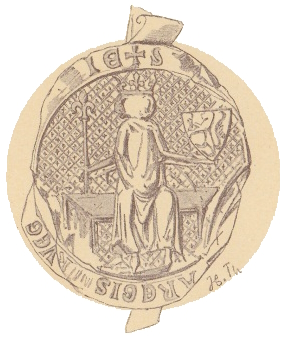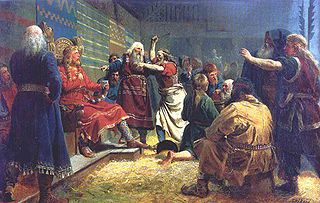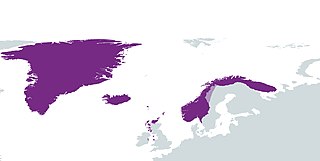Contents
| |||||
| Centuries: | |||||
|---|---|---|---|---|---|
| Decades: | |||||
| See also: | List of years in Norway | ||||
Events in the year 1380 in Norway.
| |||||
| Centuries: | |||||
|---|---|---|---|---|---|
| Decades: | |||||
| See also: | List of years in Norway | ||||
Events in the year 1380 in Norway.

Haakon IV Haakonsson, sometimes called Haakon the Old in contrast to his namesake son, was King of Norway from 1217 to 1263. His reign lasted for 46 years, longer than any Norwegian king since Harald Fairhair. Haakon was born into the troubled civil war era in Norway, but his reign eventually managed to put an end to the internal conflicts. At the start of his reign, during his minority, Earl Skule Bårdsson served as regent. As a king of the Birkebeiner faction, Haakon defeated the uprising of the final Bagler royal pretender, Sigurd Ribbung, in 1227. He put a definitive end to the civil war era when he had Skule Bårdsson killed in 1240, a year after he had himself proclaimed king in opposition to Haakon. Haakon thereafter formally appointed his own eldest son, Haakon the Young, as his co-regent.

Albert was King of Sweden from 1364 to 1389 and Duke of Mecklenburg-Schwerin from 1384 to 1412.

Haakon VI, also known as Håkan Magnusson, was King of Norway from 1343 until his death and King of Sweden between 1362 and 1364. He is sometimes known as Haakon Magnusson the Younger to distinguish him from his great-grandfather, Haakon V.

Haakon, also spelled Håkon, Hakon, Håkan, or Háukon or Hákon, is an older spelling of the modern Norwegian form of the Old Norwegian masculine first name Hákon meaning "High Son" from há and konr. An old English form is Hacon as in Haconby, Hacon's Village. The name appears in Scottish Gaelic as Àcainn, as seen in the place-name Kyleakin, meaning 'Haakon's Narrows', being named after King Haakon IV of Norway.

Blanche of Namur was Queen of Norway and Sweden as the wife of King Magnus Eriksson.

Erik Magnusson, sometimes known as Erik XII, was King of Sweden and lord of Scania in 1344–1359. He was a co-ruler with his father, King Magnus Eriksson, from 1356 until his death in 1359.
The Kingdom of Norway as a unified realm dates to the reign of King Harald I Fairhair in the 9th century. His efforts in unifying the petty kingdoms of Norway resulted in the first known Norwegian central government. The country, however, soon fragmented and was collected into one entity in the first half of the 11th century, and Norway has retained a monarchy since that time. Traditionally, it has been viewed as being ruled by the Fairhair dynasty, though modern scholars question whether the eleventh century kings and their successors were truly descendants of Harald.

The Fairhair dynasty was a family of kings founded by Harald I of Norway which united and ruled Norway with few interruptions from the latter half of the 9th century. In the traditional view, this lasted until 1387, however, many modern scholars view this rule as lasting only three generations, ending with Harald Greycloak in the late 10th century. The moniker "Fairhair dynasty" is a retrospective construction: in their lifetime what little traces there are refer to them consistently as "Ynglings".

A referendum on retaining the monarchy or becoming a republic was held in Norway on 12 and 13 November 1905. Voters were asked whether they approved of the Storting's decision to authorise the government to make the offer of the throne of the newly self-ruling country. The Storting had wanted to offer the throne to Prince Carl of Denmark, but the prince insisted that the Norwegian people have a chance to decide whether they wanted to retain a monarchy.
Rikissa Birgersdotter, also known as Rixa, Richeza, Richilda and Regitze, was Queen of Norway as the wife of the co-king Haakon Haakonson, and later Princess of Werle as wife of Henry I, Prince of Mecklenburg-Güstrow.
Knut Haakonsson was a Norwegian nobleman and claimant to the throne during the Civil war era in Norway.
Ingeborg Eriksdotter was Queen of Norway and the wife of King Magnus VI. She was born a Danish princess, daughter of Eric IV of Denmark. As queen dowager, she played an important part in politics during the minority of her son King Eirik II of Norway in 1280-82.

The Scottish–Norwegian War lasted from 1262 to 1266. The conflict arose because of disagreement over the ownership of the Hebrides. The war consisted of mainly skirmishes and feuds between the kings, and the only major battle was the indecisive Battle of Largs.
Haakon may refer to:

The House of Sverre was a royal house or dynasty which ruled, at various times in history, the Kingdom of Norway, hereunder the kingdom's realms, and the Kingdom of Scotland. The house was founded with King Sverre Sigurdsson. It provided the rulers of Norway from 1184 to 1319.
Events in the year 1374 in Norway.
Events in the year 1257 in Norway.
Events in the year 1370 in Norway.

The term Norwegian Realm and Old Kingdom of Norway refer to the Kingdom of Norway's peak of power at the 13th century after a long period of civil war before 1240. The kingdom was a loosely unified nation including the territory of modern-day Norway, modern-day Swedish territory of Jämtland, Herjedalen, Ranrike (Bohuslän) and Idre and Särna, as well as Norway's overseas possessions which had been settled by Norwegian seafarers for centuries before being annexed or incorporated into the kingdom as 'tax territories'. To the North, Norway also bordered extensive tax territories on the mainland. Norway, whose expansionism starts from the very foundation of the Kingdom in 872, reached the peak of its power in the years between 1240 and 1319.